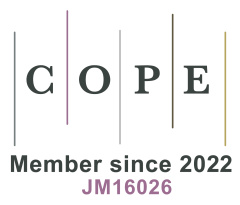Application and optimization of PINNs algorithm to 3D biomechanical heat transfer problems
Abstract
In order to investigate the effectiveness of the PINNs algorithm in the application of three-dimensional biomechanical heat transfer problems, the study uses the PINNs algorithm to construct a coupled heat-force model to simulate the temperature field and stress field distribution of different biological tissues. The experimental results show that the prediction error of PINNs is controlled within MSE 1.25 × 10−3 K and the maximum stress error is 6.9 Pa under the complex scenarios with a temperature gradient as high as 800 K/m, a heat flux as high as 6000 W/m², and a stress gradient of more than 10⁵ Pa/m. For the three different materials, namely, natural rubber, polymer, and cellular ceramics, the prediction errors are controlled within MSE 1.25 × 10−3 K. The prediction errors are controlled within MSE 1.25 × 10−3 K, and the maximum stress error is 6.9 Pa. The simulations for natural rubber, polymer, and honeycomb ceramics show that the maximum temperature of honeycomb ceramics reaches 350 K, and the thermal stress gradient is as high as 50 MPa/m, while the thermal stress gradient of natural rubber and polymer is only 5 MPa/m and 7 MPa/m, respectively. strong computational efficiency and numerical stability.
References
1. Zhu J. Exploration of the application of thermal conductivity of bio-textile materials in wearable devices: Insights from molecular biomechanics within cells. Molecular & Cellular Biomechanics. 2025; 22(1): 504-504.
2. Bowden EE, Carter JD, Bowden AE, et al. Significant Environmental Factors in the Drift of Electrical Properties in Conductive Nano‐Composite Sensors for Biomechanical Motion‐Tracking. Journal of Biomedical Materials Research Part A. 2024; 113(1). doi: 10.1002/jbm.a.37863
3. Cai S, Wang Z, Wang S, et al. Physics-informed neural networks for heat transfer problems. Journal of Heat Transfer, 2021, 143(6): 060801.
4. Kim SU, Kim JY. Development of a Biomechanical Diagnosis and Analysis System Using a Textile Elbow Angle Sensor: Integrating Inverse Dynamics and Multi-Layer Perceptron Techniques. Processes. 2025; 13(3): 748. doi: 10.3390/pr13030748
5. Salem MG, Abouelregal AE, Elzayady ME, et al. Biomechanical response of skin tissue under ramp-type heating by incorporating a modified bioheat transfer model and the Atangana–Baleanu fractional operator. Acta Mechanica. 2024; 235(8): 5041-5060. doi: 10.1007/s00707-024-03988-x
6. Li R, Zhou J, Wang JX, et al. Physics-Informed Bayesian Neural Networks for Solving Phonon Boltzmann Transport Equation in Forward and Inverse Problems with Sparse and Noisy Data. ASME Journal of Heat and Mass Transfer, 2025, 147(3): 032501.
7. Kużdżał A, Muracki J, Makar P, et al. Assessment of the Impact of Heat-Compression Therapy Time on Muscle Biomechanical Properties and Forearm Tissue Perfusion in MMA Fighters—A Pilot Study. Applied Sciences. 2024; 14(19): 8659. doi: 10.3390/app14198659
8. Schmid QT, Ruschke S, Karampinos DC, et al. Development of a 3D-knee brace joint using MRI data and a genetic algorithm. Sports Engineering. 2025; 28(1). doi: 10.1007/s12283-025-00486-8
9. Gonçalves ND, de Sá Rodrigues J. Heat Conduction Control Using Deep Q-Learning Approach with Physics-Informed Neural Networks. Metrology. 2024; 4(3): 489-505. doi: 10.3390/metrology4030030
10. Shang Y, Tan C, Yu X, et al. Using neural networks: a guidance with application in inverse heat conduction problem. European Journal of Physics. 2025; 46(2): 025102. doi: 10.1088/1361-6404/ada741
11. Baldan M, Di Barba P. Energy‐based PINNs for solving coupled field problems: Concepts and application to the multi‐objective optimal design of an induction heater. IET Science, Measurement & Technology. 2024; 18(9): 514-523. doi: 10.1049/smt2.12212
12. Song Y, Yuan X, Yue H. The ADMM-PINNs Algorithmic Framework for Nonsmooth PDE-Constrained Optimization: A Deep Learning Approach. SIAM Journal on Scientific Computing. 2024; 46(6): C659-C687. doi: 10.1137/23m1566935
13. Kokash H, Khanafer K, Burzo M. Machine Learning-Based Predictions of Flow and Heat Transfer Characteristics in a Lid-Driven Cavity with a Rotating Cylinder. Energies. 2024; 17(20): 5220. doi: 10.3390/en17205220
14. Edalatifar M, Shafi J, Khalid M, et al. An artificial intelligence approach for the estimation of conduction heat transfer using deep neural networks. International Journal of Numerical Methods for Heat & Fluid Flow. 2024; 34(8): 3107-3130. doi: 10.1108/hff-11-2023-0678
15. Singhal M, Goyal K, Singla RK. A review of regularization strategies and solution techniques for ill-posed inverse problems, with application to inverse heat transfer problems. Reviews in Mathematical Physics. 2023; 36(01). doi: 10.1142/s0129055x23300078
Copyright (c) 2025 Author(s)

This work is licensed under a Creative Commons Attribution 4.0 International License.
Copyright on all articles published in this journal is retained by the author(s), while the author(s) grant the publisher as the original publisher to publish the article.
Articles published in this journal are licensed under a Creative Commons Attribution 4.0 International, which means they can be shared, adapted and distributed provided that the original published version is cited.



 Submit a Paper
Submit a Paper
